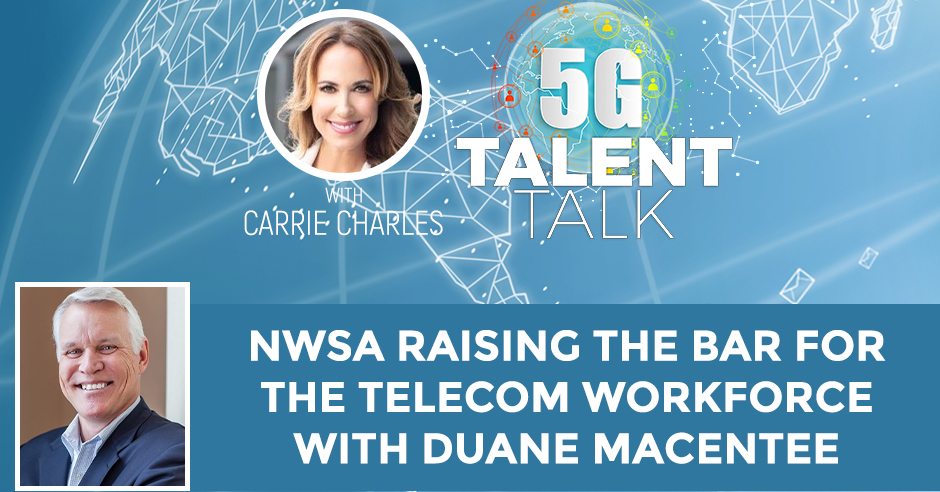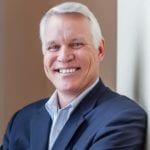
For the existing telecom workforce, there are many very dedicated men and women out there who are deploying 5G technology infrastructure. It’s critical to the American public to have that and to be the first to achieve it, but also to make sure that those workers not only come to work but go home at night safe. Om today’s show, Duane MacEntee, the Executive Director of the NWSA (National Wireless Safety Alliance), joins Carrie Charles to talk about how NWSA is raising the bar for the telecom workforce through its ANSI accreditation and the journey and motivation behind this goal.
—
Listen to the podcast here:
Watch the podcast here:
NWSA Raising The Bar For The Telecom Workforce With Duane MacEntee
We are going to be talking about a major milestone that has been reached along the journey of 5G. We’ll talk about how that milestone is going to affect employees, employers, and the wireless industry as a whole. I’m super excited to have on the show with me, Duane MacEntee. He is the Executive Director of the National Wireless Safety Alliance and an Attorney and Founding Partner at Barker MacEntee. Duane, thanks for being on the show.
You’re welcome, Carrie. Thank you for having me.
Tell me more first about Barker MacEntee. What do you do? Who are your clients? Who do you serve?
We’re a small boutique law firm that focuses its practice area on engineering firms and contractors in the industry that deploy wireless networks. We perform services such as outside general counsel. We advise on policy processes, risk management, and insurance matters. We’ve expanded to include mergers and acquisitions. We represent our clients in that regard too, but we are mostly targeting smaller and midsize engineering firms and contractors in the industry.
Tell me about the National Wireless Safety Alliance and your role as executive director.

Telecom Workforce: There’s a big difference between a trade certification and a training certificate, although both are very important.
Before we get into my role, let me talk about the NWSA. First of all, we’re not an association. We are an entity as a 501(c)(6) nonprofit that was formed by the industry, literally for the industry. We were a byproduct of a big collaborative effort between a very broad coalition of industry stakeholders or consensus body. We provide accredited, nationally recognized independent assessments that are verifiable and portable to the employee for knowledge and skills as technicians on towers. That’s the nutshell of it. We’re a certification body for tower technicians without a training effort. We don’t do training, where we’re solely in the business of conducting tests, examinations and certifying technicians. As far as my role, like any executive director in a nonprofit, I helped the board of governors and directors with good governance.
I’m working on the mission, implementation, planning, reporting to the board, and making sure that resources are used wisely. We are focused very heavily on people. We’re a volunteer-driven organization. All of our subject matter experts are volunteers and they come from all aspects of the industry. We want to make sure that those SMEs are aligned with our goals and program development. Developing the certifications that the industry says are important as a worker, as an employer, as the industry, as a whole, as you mentioned previously. There’s always the money aspect of it. We are a nonprofit. You got to put a little plugin for that. We rely very heavily on the good graces of many generous organizations in the industry. We budget and try to be good stewards of that money.
You said something very important, which is the word accredited, and that’s what I want to talk about with you. NWSA was awarded the ANSI accreditation, which is very exciting. What does this mean? This is a multipart question. What was the motivation behind this goal? Please talk about the long journey to get there.
Let me get a historical perspective. I’ve been in the industry for many years. In a blink of an eye, it went by so quickly. Back in the 2013 or 2014 timeframe, the industry was getting tagged with not the reputation we want it. We were leading the nation for fatalities per capita in our industry. We got the attention of the Department of Labor, OSHA, and other governmental bodies. We were labeled at one point as the most hazardous industry in the nation, which is not what you want to be number one in ever. These are people’s lives that we’re talking about. The motivation was to improve safety in our industry and to do something about it ourselves, to self-regulate to make sure that we’re doing it properly. The journey has been tremendous.
I’ve met so many wonderful people that have donated thousands of hours of time to make this happen. Back in 2013, at that timeframe of a lot of turbulence and reputation that we didn’t want to see, a group got together in Dallas. They formed a safety task force. It was the brainchild of one of the industry leaders, Black & Veatch, a gentleman by the name of Martin Travers. He got together with some other industry leadership and putting the NATE organization, National Association of Tower Erectors and they conceived a meeting. They brought together broad stakeholders, carriers, tower owners, and contractors. There was a huge group gathered in Dallas, Texas back in 2013. The outcome from that was to come up with a method of improving the proficiency of the workforce, meaning start out as a safety focus, which is very safety-driven, but the correlation between safety and quality can’t be underestimated. It’s inseparable.
The correlation between safety and quality can't be underestimated; it's inseparable.
Click To Tweet
That was the launching pad of an idea. From that, a matrix was developed, a national consensus matrix of what are the skills and abilities that we want to see in a well developed proficient workforce? Fast forward to 2015, the National Wireless Safety Alliance was incorporated as a nonprofit organization. We formed our board of directors and board of governors. The board of governors is unique in that there were 31 seats representing every aspect of the industry. I mentioned carriers, tower owners, contractors of all sizes, and tower climbers.
At that time, we call them tower climbers, but now technicians, we used to say. Accreditation means something and I’ll get to that in a moment, but it was consensus body of the industry for the industry to make sure that we are doing it right. We now have an accredited trade certification. There’s a big difference between a trade certification and a training certificate. Both are very important. You have to have good training. You want to have an acknowledgment that workers have gotten trained, but the accredited trade certification is that professional moniker that you carry with you, not unlike certified welders, electricians, other professional trades that exist in the United States. It’s very similar.
Why is this great for the wireless industry?
There’s a big difference. You need both the certificates and the certifications, but the trade certification is the most valuable of the two in the sense that we now have a standardized method of independent verification through assessments that are statistically validated through the antsy accreditation process, which is under an international organization standards. It’s a very in-depth effort, you have to go through to get there. It’s something you can rely on. It’s verified. It’s validated. It is what it is. It’s a good certification that means something now to the trade.
Let’s split the workers up in two categories to the existing workforce and then the new incoming workforce. Talk about the benefits to each group of individuals.

Telecom Workforce: Whether through a third party training company, a community college or trade school, or in-house training programs, it doesn’t matter which road you take; all roads lead to NWSA certification.
Let’s start with the existing workforce because of the new and incoming workforce, those same benefits apply, but we add to it. For the existing workforce, there are a lot of very dedicated men and women out there that are deploying 5G technology infrastructure. It’s critical to the American public to have that, to be the first to achieve it. There are many implications there internationally and we want to be the first to do that, but to do so, we want to make sure that those workers not only come to work but go home at night safe. A safer environment is the first priority with knowledge and skills that are truly verified in an independent way that is standardized across the nation. A worker in Florida has the same credential as a worker in Washington State and those two individuals have that certification that is portable. It goes with that worker.
It is a portable credential that travels with the worker. It’s not tagged to any employer. It’s irrespective of who employs that worker or that technician. It’s a reputable, standardized assessment that you use to do that. It’s professionalism. If you think about it, for a long time in this industry, in many cases has self-identified with less than professional titles. We want to avoid that. We are now coming of our own age in the professional realm. For new and incoming workforce, all of those same benefits apply. However, as we look at workforce development, the need to have more workers supporting the fifth-generation wireless deployments and communication networks, generally, whether you’re on a tower or you’re planting fiber or whatever you’re doing, we want to make sure that the workforce coming in to perform those tasks are adequately trained.
We’re one piece of the puzzle. Certification is at the end of the spectrum. On the frontend, at the very beginning, you have to attract workers in somehow. You have to bring them into either a school or an employer that’s going to invest in their training and you want to attract them and retain them. Creating a pathway, a career progression that they can clearly see the technician 1 and technician 2 specialty areas and foreman certifications. They now have a path that they can clearly see a career, not just a job, but something that can sustain them in their families for years to come. That’s what we were hoping to achieve working with NATE and with WIA’s TIRAP. Those are all very important pieces of this workforce development puzzle.
Let’s talk now about the benefits of this accreditation to employers.
As I described, the stakeholders that participated in the development of the programs are predominantly employers. When you think about who gets together and I want to emphasize at some point, in this conversation, how the testing for the certifications are developed. The employer-based contractors predominantly large, medium, and small got together, and they worked hard at making sure it was something that was useful to them in terms of the skills and abilities that they want to see in a technician and it levels playing field. Think about companies that are hiring people in. They want to make sure that that person is qualified without having to waste resources to find that out. That’s a benefit right on the outset, but it also does level the playing field from a competitive standpoint. Unfortunately, we know there are contractors that are not always doing everything that we’d like them to do. This is an opportunity to incentivize those contractors to hire those qualified workers that have been verified and it’s valid that they are able to do the job that their contractors hired them to do.
What types of certifications are available now and what’s on the horizon?
When we talk about accreditation, we have two certification programs of our portfolio that have been accredited by the ANSI National Accreditation Board. It’s ANAB. It’s an ANSI accreditation. The telecommunications tower technician level 1 and level 2 are two programs that have been accredited with ANSI. We also have what’s known as an Antenna & Line Specialty Certification, which rides on top of Triple T2 the technician two-level. You have to have the technician two to be able to sit for that. Above that and there’ll be more specialties. We have on deck, advanced reading concepts, structure modifications, we’re looking at a small cell. We don’t know where that’s going to be a specialty or that’s going to be a certification of its own if we go that route.
It’s up to the board of governors. That’s their role is to guide us. They are the industry. They guide us in what we should be doing. On top of those specialties is a foreman. it’s the first time ever in this industry that we’ve had some certificate that goes to that level of leadership. That’s predominantly what that test is about is 45% of the questions on that test are made up of leadership qualities, making sure that foreman understands the role, not just on the tools, but how to work with and through others to get the job done.
Who does the training?
The beauty of this program is everyone does the training. We’re very much indifferent to how training is conducted. We want good training. There is no question that we have to have good training. Whether it’s through a third-party training company or through a community college or trade school or through in-house training programs that some contractors have developed, it doesn’t matter which road you take. All those roads lead to NWSA certification. What we want to make sure is that our test is a valid test.
That the technician, when they come to it, they have had the appropriate training and that we validate with some level of certainty that on that day, they’ve had that training. We test enough of the elements or various domains, knowledge domains that we want to know that they have a mastery of, and we test them on it. It is one of the beauties of the ISO, International Standards Organization standard 17024. It’s a very deliberate and disciplined approach in making sure that our testing is achieving what we want it to. That’s why accreditation is important.
Are they test in any other language?
Our board of directors and board executive committee have approval now to move forward with Spanish language testing. In 2020, we will be going through the development phase of that. Once again, under this standard that we have to live by for accreditation, we need to make sure that the translation is done properly. In and of itself, it is its own process but in 2020, we will launch a Spanish version of the Triple T1 and Triple T2.
This is so exciting and everything’s a process. It takes time, but the great news is, is that you’ve made so much progress up to this point and it’s much needed in the 5G workforce. There’s been the skills gap that everyone talks about. There’s a workforce shortage. There have been all kinds of issues and crises around the workforce. What does this accreditation mean for the future 5G workforce? Let’s speed up the movie and what’s going to change in the future based on this accreditation?
It’s been debated how many workers are needed to support the fifth-generation rollout, 5G rollout. No matter who you’re speaking with, it is a lot. We don’t know the exact number, but we think it’s a lot. What accreditation means to that workforce, both existing and the new blood that we have to bring in to do this is it’s something they can put a stake in the ground to say, “There’s a career to be made of this. We need the best and the brightest to step up and step into this industry.” We’re competing with other industries. Frankly, there’s an opportunity for us if we take advantage of it, to show that new workers, that veteran that’s transitioning can come into our industry and they now have a trade that they can come into and do work for. We need that for the fifth generation.
One of the beauties of the way NWSA has to be structured through its governance and through the board of governors, that broad coalition, that broad cross-section, we may not be as nimble. We have to be deliberate in the way we do it, but we hear feedback constantly about the needs of the industry and we adapt. We have to. That’s our mission. We don’t have to adapt the accreditation but we adapt the credential, but we will make sure that we are meeting the needs of the industry by listening to the industry.
I’m speaking I’m sure on behalf of the entire industry when I say thank you, Duane, for everything that you’ve done along with your incredible team and this is something that has made a difference and will make a difference in the lives of thousands of people and save lives as well. Where can we learn more about NWSA if somebody wants to learn about the accreditation, the trainee or the testing or an employer wants to learn more?
The best way to do that is to go to our website www.NWS-A.org. That’ll take you to our website, which has all this information. Frankly, for those that are interested in what it means to become certified, there’s a candidate handbook, download that. It’s available free of charge. It walks through the entire program from a candidate’s perspective so they can see what it takes to become certified and what the elements of it are. It’s important that they understand what they’re getting into.
Tell me where we could learn more about Barker MacEntee?
My firm has a website too. It’s a www.BarkerMcEntee.com. I’d like to give a shout out to all of the volunteers and staff from the industry and from our vendor partners that have made this a reality. Our ability to become accredited took hundreds of volunteers and staff and countless thousands of hours’ worth of effort over the course of the last many years. We appreciate it.
Hats off to you all. Thank you for being on the show. It’s an important topic. We truly appreciate all that you and your team have done to get us to this place.
Thank you for all that you do as well and getting the word out.
Important Links:
- National Wireless Safety Alliance
- Barker MacEntee
- Black & Veatch
- WIA’s TIRAP
- National Association of Tower Erectors
- www.NWS-A.org
- www.BarkerMcEntee.com
About Duane MacEntee
 Duane MacEntee is a partner in the law firm of Barker MacEntee PLLC and is focused on representing contractors and engineering companies in the communications infrastructure industry. Duane’s firm provides industry-specific outside general counsel services, policy and process development, crisis response, contract reviews and merger & acquisition representation. Duane counsels clients on risk management, regulatory compliance, business practices and customer/vendor contracts applicable to engineering and construction services.
Duane MacEntee is a partner in the law firm of Barker MacEntee PLLC and is focused on representing contractors and engineering companies in the communications infrastructure industry. Duane’s firm provides industry-specific outside general counsel services, policy and process development, crisis response, contract reviews and merger & acquisition representation. Duane counsels clients on risk management, regulatory compliance, business practices and customer/vendor contracts applicable to engineering and construction services.
In addition, Duane is the Executive Director of the non-profit National Wireless Safety Alliance and has enjoyed the past 20 years serving in leadership, business management and technical roles within the communications industry. He has in-depth business experience in network infrastructure services and has held operational executive roles with major tower owners, engineering and fabrication companies, and contractors that deploy broadband wireless and fiber networks.
Earlier in his career, Duane directed safety, environmental remediation and workers’ compensation programs as Director of Safety and Loss Control at the NC Department of Transportation, served as a Commissioner on both the NC Radiation Protection and NC State Emergency Response Commissions and was an engineer at the Kennedy Space Center in Florida.
Duane earned a B.S. in Engineering Technology from the University of Central Florida, an M.B.A. from the Florida Institute of Technology, and a J.D. from North Carolina Central University.
The post NWSA Raising The Bar For The Telecom Workforce With Duane MacEntee appeared first on RCR Wireless News.
